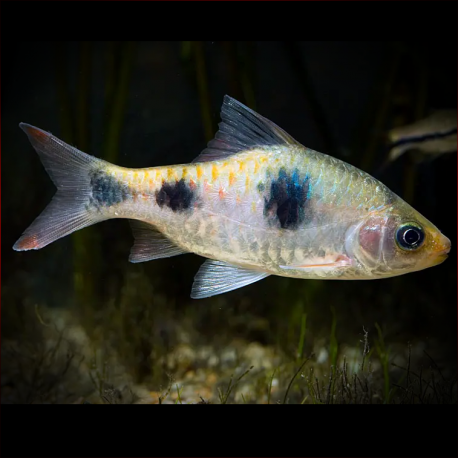More info
Datasheet
| Minimum Tank Size | 240 litres / 63.40 US gallons |
| Maximum Size | 9.0cm / 3.54inches |
| Temperature | 18°C / 64.40°F - 25°C / 77.00°F |
| Hardness | 2.02dgH / 36ppm - 10.03dgH / 179ppm |
| pH | 6.0-7.5 |
General Description
The Dawkinsia Rubrotinctus, previously known under misapplied names such as Puntius arulius and P. tambraparniei, is a riverine species endemic to southern India. Belonging to the Cyprinidae family, it was revalidated in 2011 and placed within the Dawkinsia genus. This species showcases three distinct dark markings on its body, setting it apart from most congeners.
Aquarium Setup
Maintaining Dawrkinsia Rubrotinctus in a well-sized tank of at least 240 litres is recommended, following a natural-style setup with sand or gravel substrate, rocks, driftwood, and live plants like Microsorum or Anubias. The species thrives in well-oxygenated water with moderate flow, ideally achieved through oversized external filters. Regular water changes of 30-50% tank volume are crucial for maintenance (see table).
Behaviour
Being a schooling species by nature, Dawkinsia Rubrotinctus thrives best when housed in groups of 8-10 individuals. It exhibits hierarchical behavior within the group, ensuring containment of any potential aggression. In a community tank setting, it is compatible with peaceful species that are bold enough not to be intimidated by its active nature and size.
Feeding and Diet
This species is considered a foraging omnivore, feeding on a variety of organisms in nature such as worms, insects, and plant material. In captivity, a balanced diet including live and frozen foods like bloodworms and Daphnia, alongside high-quality dried flakes and granules, ensures optimal health and vibrant colors.
Reproduction & Dimorphism
Dawkinsia Rubrotinctus is an egg-scattering free spawner without parental care. To maximize breeding success, a separate tank with dim lighting and suitable substrate for egg collection should be set up. Adult females are slightly larger, less brightly colored, and thicker-bodied than males, especially when gravid. Fry require microscopic food initially before transitioning to larger options.
Habitat and Distribution
Originally discovered in the Mananthavadi River in Kerala, southern India, Dawkinsia Rubrotinctus is now believed to be widespread throughout the Cauvery drainage in Karnataka, Kerala, and Tamil Nadu. Its exact distribution remains partially uncertain due to similar-looking species and potential hybrids with D. assimilis, especially in the Kallada River region within southern Kerala.

